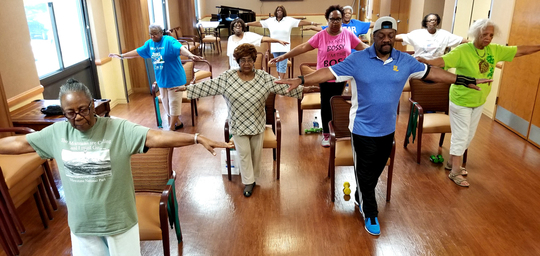|
2017 NCOA Falls
Free® Photo Contest Winner: Asbury Harris Epworth Towers/Wesley Woods
Senior Living; Atlanta, GA
By Keri Ann Lipperini, MPA, Director of the Office of
Nutrition and Health Promotion Programs
One in
four adults aged 65 or older falls each year, often in or near their homes.
While many falls are minor, an older adult dies from complications from a
fall every 19 minutes. Falls are so common that if you are a caregiver of
an older family members, I am sure you can relate to this issue.
As a
professional in the aging field for more than 20 years, I’ve seen what can
happen when an older person falls. And like many of you, it has touched my
family. My grandmother had a fall because she slipped on a throw rug. Yes,
despite my numerous conversations about the dangers of them, grandma was
persistent on keeping those throw rugs. To grandma, I was not an aging
expert, I was the little girl with the pigtails. So, unfortunately this
resulted in a woman who had lived independently in her home until she was
90-years old landing in a nursing home for the last six-months of her life.
An
injury from a fall may sideline younger people for a few days or weeks, but
recovery is usually quick and complete. But for older people like my
grandma, the consequences of falls can become far more serious, setting up
a sequence of events that can compromise independence and health.
That’s
why we at the Administration on Community Living take Falls Prevention Week
seriously. We want to get the word out to older people and their families
about risk factors for falls and ways to prevent them. Preventing falls can
help older people continue to live independently in their own homes and
communities—which is at the heart of ACL’s mission.
Certain
factors put older people at higher risk for falls. These include:
- Physical health: People with chronic
diseases and poor physical health are at greater risk. Problems with
dizziness, balance, vision, and other conditions can increase the risk
of falls.
- Environment: Hazards in and around the
home—loose throw rugs, obstructed pathways, difficult to access
showers or bathtubs—make falls more likely. Or, wearing poorly fitted
shoes, slippers, or shoes with limited support.
- Behavior: Lack of sleep, alcohol
use, and lack of exercise all increase the risk of falls.
What
can people do to prevent falls? Here are some tips:
- Stay active: Exercise helps increase or
maintain coordination and muscle tone that can keep us steady on our
feet and our reactions sharp. Walking, swimming, and taking exercise
classes are just a few ways to keep the heart healthy and
muscles toned. ACL-supported programs offered by the aging network can
help. These include programs such as Tai Chi:
Moving for Better Balance and Fit and Strong!
- Manage underlying chronic conditions:
The better a person’s overall health, the lower the risk of falls.
Chronic conditions like diabetes, depression, osteoarthritis, obesity,
and high blood pressure can increase the risk of falls. Managing those
conditions—by seeing a health care provider regularly, taking
medication as prescribed, eating a healthy diet, and choosing
appropriate exercise—can help prevent falls. ACL-supported programs
offered by the aging network such as the Chronic
Disease Self-Management Program help older people learn to
manage their chronic conditions, communicate better with their
doctors, and deal with problems such as frustration, fatigue, and
pain. This peer-facilitated program is highly participatory, with
participants learning from each other and working on goals that matter
to them.
- Review medications:
Side effects from and interactions with some common medications can
increase the risk of falling. Regular conversations with health care
providers and the pharmacist about all prescription and
over-the-counter medicines can help avoid these problems.
- Get an Eye Checkup:
Vision changes as we get older, so it is important to have a checkup
once a year to make sure prescriptions are up to date and to screen
for diseases of the eye, like cataracts and glaucoma, which usually
are treatable when caught early.
- Eliminate potential hazards in the environment.
A thorough assessment of a home can be a lifesaver. Enlisting the help
of a family member or friend who doesn’t live there is a good way to
avoid overlooking things, too. Installing grab bars in the bathroom,
getting rid of slippery throw rugs or adding a rubber backing to them,
and keeping passage ways inside and outside the home well-lit and free
from clutter and debris are simple things that can make a big
difference.
- Shoes Matter!! Sensible shoes with a high back,
hard, slip-resistant sole, and a low heel height (one inch or less)
are best to wear outside. It’s important to wear them properly, with
the back of the shoe snugly behind the heel.. Slipping into them
part way may be convenient, but is unsafe – it is the back support
that stabilizes the shoe and often prevents a fall. Shoes or slippers
that are loose or ill-fitting, or with worn outer soles should be
avoided. Also, shoes with smooth leather or plastic soles can be
slippery, especially on wet floors.
ACL is
working with partners and people across the nation to realize our goal of
making community living possible for everyone. ACL funds the National Falls Prevention Resource Center, which is leading the way in helping our
nation’s older adults prevent falls. The National Falls Prevention Resource
Center has developed excellent tools and resources for older adults,
service providers, and caregivers who are looking to do more to prevent a
fall. Check out this excellent webpage for tips, advice, and a great video-
Preventing Falls: Tips for Older Adults and
Caregivers
Falls
are not a normal part of aging. This week is all about recognizing that
falls are preventable and making changes to prevent them! Take action today.
Falls
Prevention Week is September 22 to 28, 2018
|


No comments:
Post a Comment